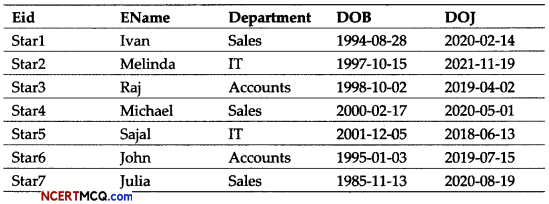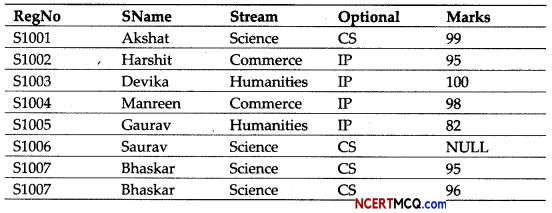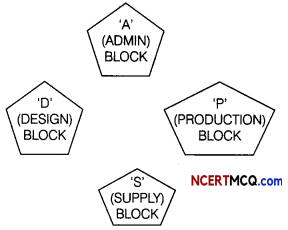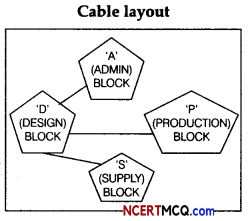Students can access the CBSE Sample Papers for Class 12 Informatics Practices with Solutions and marking scheme Term 2 Set 1 will help students in understanding the difficulty level of the exam.
CBSE Sample Papers for Class 12 Informatics Practices Term 2 Set 1 with Solutions
Maximum Marks : 35
Time : 2 hours
Instructions:
- The question paper is divided into 3 sections – A, B and C.
- Section A, consists of 7 questions (1-7). Each question carries 2 marks.
- Section B, consists of 3 questions (8-10). Each question carries 3 marks.
- Section C, consists of 3 questions (11-13). Each question carries 4 marks.
- Internal choices have been given for question numbers -1, 3, 8 and 12.
Section – A
(Each question carries 2 Marks)
Question 1.
Aman, a freelance website developer, has been assigned a task to design few web pages for a book shop. Help Aman in deciding out of static web page and dynamic web page, what kind of web pages should be designed by clearly differentiating between static and dynamic web pages on atleast two points?
Or
Priyanka, a beginner in IT field has just started learning web technologies. Help her in understanding the difference between website and web pages with the help of a suitable general example of each.
Answer:
He should develop dynamic web pages as they are richer with features, interactive and are better in performance.
Differentiation between static and dynamic web pages are as follows:
| Page | Dynamic Web Page |
| In static web pages, pages will remain same until someone changes it manually. | In dynamic web pages, content of pages are different for different visitors. |
| Static web pages are simple in terms of complexity. | Dynamic web pages are complicated. |
| In static web pages, information are change rarely. | In dynamic web page, information are changed frequently. |
| Static web page takes less time for loading than dynamic web page. | Dynamic web page takes more time for loading. |
| Static web pages are written in languages such as HTML, JavaScript, CSS, etc. | Dynamic web pages are written in languages such as CGI, AJAX, ASP, ASP.NET, etc. |
Or
A website is a collection of web pages. Whereas, a web page is a single page/file.
Just as a book is a collection of multiple pages.
| Website | Web Page |
| 1. Website is a collection of web pages displayed on the web with a client like browser. | 1. It is part of website that includes information and content and is displayed on the browser to user or visitor. |
| 2. It is a combination of web pages created using HTML and CSS. | 2. Information is usually written in HTML language. |
| 3. It requires more time to develop the website as compared to web pages. | 3. It requires less time to develop a web page as compared to the website. |
| 4. It includes content about Several entities. | 4. It includes content or information about a single entity. |
| 5. There is no such extension included in the URL of the website. | 5. URL of web page include extension. |
| 6. It is quite hard and complex to create the structure of the website and its programming. | 6. It is quite easy and simple to develop web page after website structure is being created. |
![]()
Question 2.
(i) I
- am a small text file.
- created on a user’s computer.
- contain small pieces of data – like a username, pass ward and user’s browsing history as well as preferences.
- may help to improve user’s web browsing experience.
Who am I?
Answer:
Cookie A cookie (called an Internet or web cookie) is the term given to describe a type of message that is given to a web browser by a web server. The main purpose of a cookie is to identify users and possibly prepare customised web pages or to save site login information.
When you enter a website using cookies, you may be asked to fill out a form providing personal information like your name, E-mail address and interests. This information is packaged into a cookie and sent to your web browser, which then stores the information for later use. The next time you go to the same website, your browser will send the cookie to the web server. The message is sent back to the server each time the browser requests a page from the server.
(ii) Name any two popular web browers.
Answer:
Internet Explorer, Mozilla Firefox.
Question 3.
Predict the output of the following queries.
(i) SELECT P0WER(5, 3);
(ii) SELECT M0D(5, 3);
Or
Briefly explain the purpose of the following SQL functions.
(i) POWER( )
(ii) MOD( )
Answer:
(i)

The POWER(x,y) returns x<sup>y</sup>, hence POWER(5,3) returns 5<sup>3</sup> = 125.
(ii)

MOD(x,y) returns the remainder of dividing x by y. Hence, MOD(5,3) returns 2.
Or
(i) POWER() function returns the value of a number raised to the power of another number.
(ii) MOD() function returns the remainder of a number dividing by another number.
Question 4.
Navya has just created a website for her company and now need to host it. Briefly discuss the role of a web server in hosting a website.
Answer:
A web server is the residence of web pages. It is also the agent that fetches the web pages when the web pages are requested by clients.
The main job of a web server is to display website content through storing, processing and delivering web pages to users. All computers that host websites must have web server software. Web servers are used in web hosting or the hosting of data for websites and web-based applications or web applications.
Question 5.
Help Reshma in predicting the output of the following queries.
(i) SELECT R0UND(8.72,3);
Answer:

ROUND() function rounds a number to certain decimal places. Here, number of decimal places is 3 and the number is 8.72 . So, the output will be 8.720
(ii) SELECT ROUND(9.8);
Answer:

ROUND() function rounds a number to certain decimal places. Here, number of decimal places is 0 . So, as per rounding rules the integer part increases by 1 to give 10.
Question 6.
Aryan, a database administrator, has grouped records of a table with the help of GROUP BY clause.
He needs to further filter groups of records generated through GROUP BY clause.
Suggest suitable clause for it and properly, explain its usage with the help of an example.
Answer:
He needs to use the HAVING clause. Just as the WHERE clause filters individual records on a condition, the HAVING clause can be used to filter groups on basis of a condition.
eg.
SELECT Dept, COUNT!*) FROM Emp GROUP BY Dept;
Groups the records on Emp table by Dept and displays count of employees in each department.
SELECT Dept, COUNT!*) FROM Emp GROUP BY Dept HAVING C0UNT(*)>5;
Groups the records on Emp table by Dept and displays count of employees in each department, but only those departments are shown whose number of employees are >5.
Question 7.
Mr. Som, a HR Manager in a multinational company “Star-X world”, has created the Emp table to store the records of employees.
Table: Emp

He has written following queries
(i) SELECT MAXCYEAR(DOB)) FROM Emp; .
(ii) SELECT EName FROM Emp WHERE M0NTH(D0J)=11;
Predict the output.
Or
Based on the table given above, help Mr. Som writing queries for the following task.
(i) To display the name of eldest employee and his/her DOB.
(ii) To display the name of those employees whose joining month is May.
Answer:
(i)

YEAR(DOB) returns the year part of each DOB and MAX() finds the maximum value among these.
(ii)

MONTH(DOJ) extracts the month part of a date which is compared to 11. Here, the only employee with 11 as DOJ is “Melinda”.
Or
(i) SELECT Ename, DOB FROM Emp WHERE DOB = (SELECT MIN (DOB) FROM Emp);
(ii) SELECT Ename FROM Emp WHERE MONTH (DOJ)= 05;
![]()
Section – B
(Each question carries 3 Marks)
Question 8.
Predict the output of the following queries.
(i) SELECT INSTRC’exams@cbse.nic.in’,’.’):
(ii) SELECT SUBSTR(‘exams@cbse.nic. in’,7.4);
(iii) SELECT LEFT(‘ exams@cbse. nic. i n’, 5);
Or
Ms.Saumya is working on a MySQL table named ‘Hotel’ having following structure
Table: Hotel

She need to perform following task on the table.
(i) To fetch last 2 characters from the user_id column.
(ii) To display the values of name column in lower case.
(iii) To display 3 characters from 3rd place from the column city.
Suggest suitable SQL function for the same. Also, write the query to achieve the desired task.
Answer:
(i)

The INSTR() function returns the position of String2 in Stringl. Hereis present in position 11 of the string exams@cbse.nic.in.
(ii)

The SUBSTR() function extracts certain number of characters from a start position and number of characters specified. Here SUBSTR(exams@cbse.nic.in,7,4) extracts 4 characters from position 7 of the string.
(iii)

The LEFT() function extracts certain number of characters from left of a string. Here, LEFT(exams@cbse.nic.in, 5) extracts 5 characters from left of the string.
Or
(i) Function RIGHT()
Quay SELECT RIGHT(user_id,2) FROM Hotel;
(ii) Function LCASEQ
Query SELECT LCASE(name) FROM Hotel;
(iii) Function SUBSTR()
Query SELECT SUBSTR(city, 3, 3) FROM
Question 9.
Reena is working with functions of MySQL. Explain her following
(i) What is the purpose of NOW() function?
Answer:
The NOW( )function returns the system date and time.
(ii) How many parameters does it accept?
Answer:
0 parameters
(iii) What is the general format of its return type?
Answer:
“YYYY-MM-DD HH: MM : SS”.
![]()
Question 10.
While dealing with string data type in MySQL, its observed that sometimes unnecessary space character comes in between which hampers the successful executing of a string manipulation module. Name the suitable MySQL function(s) to remove leading, trailing and both type of space characters from a string. Also, give MySQL queries to depict the same.
Answer:
(i) To remove leading spaces – LTRIM()
e.g. SELECT LTRIM( “Spaces”);
Output:

(ii) To remove trailing spaces — RTRIM()
e.g. SELECT RTRIMC’Spaces”);
Output:

(iii) To remove spaces in both sides— TRIM()
e.g. SELECT TRIM(” Spaces ”);
Output:

Section -C
(Each question carries A Marks)
Question 11.
Carefully, observe the following table named ‘stock’
Table: Stock

Write SQL queries for the following
(i) To display the records in decreasing order of Price.
Answer:
SELECT * FROM Stock ORDER BY Price DESC;
(ii) To display Category and Category wise total Quantities of products.
Answer:
SELECT Category, SUM(Qty) FROM Stock GROUP BY Category;
(iii) To display the Category and its average Price.
Answer:
SELECT Category, AVG(Price) FROM Stock GROUP BY Category;
(iv) To display Category and Category wise highest Price of the products.
Answer:
SELECT Category, MAX(Price) FROM Stock GROUP BY Category;
Question 12.
Satyam, a database analyst has created the following table
Table: Student

He has written following queries
(i) SELECT SUM(Marks) FROM Student WHERE Optional= IP’ AND Stream= ‘Commerce’;
(ii) SELECT MAX(Marks)+MIN(Marks) FROM Student WHERE Optional= ‘CS’:
(iii) SELECT AVG(Marks) FROM Student WHERE Optional ‘IP’;
(iv) SELECT LENGTH(SName) FROM Student WHERE Marks IS NULL;
Help him in predicting the output of the above given queries.
Or
Based on the above given table named ‘Student’, Satyam has executed following queries
SELECT COUNT(*) FROM Student;
SELECT COUNT(Marks) FROM Student;
Predict the output of the above given queries.
Also, give proper justifications of the output generated through each query.
Answer:
(i)

The SUM() function returns sum of values in a column. Here, the condition is Optional = “IP” and Stream=”Commerce”, sum of marks of these records gives 193.
(ii)

The MAX() and MIN() functions return the maximum and minimum values in a column. Here, the maximum and minimum values are 99 and 95 for Optional=”CS”. Sum of the two gives 194.
(iii)

The AVG() function returns the average of values in a column. Here, the condition is optional=”IP”. Average of these values of marks gives 93.75.
(iv)

The LENGTH() function returns the length of a string value. Here the condition is Marks IS NULL, for which there is only 1 matching name that is “Saurav” whose length is 6.
Or
(i)

COUNT(*) function counts the number of records in a table. Here, the number of records is 8.
(ii)

COUNT(Marks) returns the number of NON NULL values in the marks column. Here, we have 7 values.
![]()
Question 13.
“Anutulya Creations”-A start-up fashion house has set up its main centre at Kanpur, Uttar Pradesh for its dress designing, production and dress supplying activities. It has 4 blocks of buildings.

Numbers of computers in each block:
| Block A | 20 |
| Block D | 80 |
| Block P | 15 |
| Block S | 8 |
Based on the above specifications, answer the following questions. .
(i) Out of LAN, WAN and MAN, what type of network will be formed if we interconnect different computers of the campus? Justify.
Answer:
A LAN network is formed. LAN or Local Area Network is a network of systems spread in a small area thar spans for 500m to lKm approx. Here the distances between the offices is maximum 150m.
(ii) Suggest the topology, which should be used to efficiently connect various blocks of buildings within Kanpur centre for fast communication.
Also, draw the cable layout for the same.
Answer:
Star topology should be used.

Star topology has the best features such as error detection, easy attachment of nodes etc.
Since Block D has the maximum number of computers, if the other buildings are connected to it, the communication will be faster.
(iii) Suggest the placement of the following device with justification.
(a) Repeater
(b) Hub/Switch
Answer:
(a) Repeater A to S and P to D.
Since the distances between the blocks are 110m and 150m respectively a repeater will be required to amplify the signals.
(b) Switch/Hub Its will be required in all the buildings to connect multiple computers present in them.
(iv) Nowadays, video-conferencing software is being used frequently by the company to discuss the product details with the clients. Name any one video conferencing software.
Also, mention the protocol which is used internally in video conferencing software.
Answer:
Video conferencing softwares Zoom, Google Meet
Protocol VoIP (Voice over Internet Protocol)